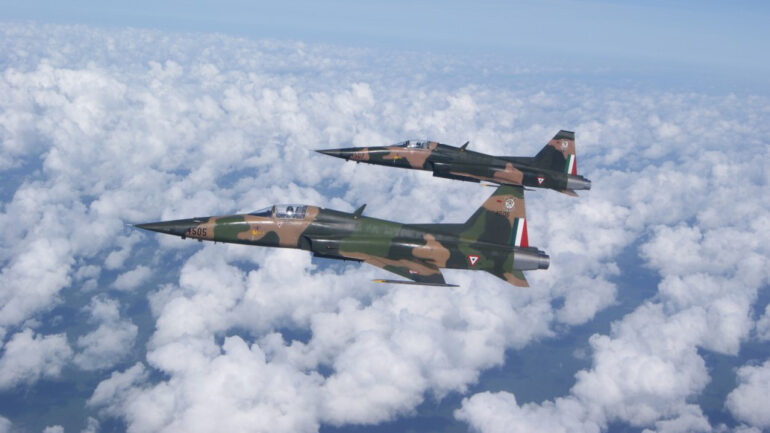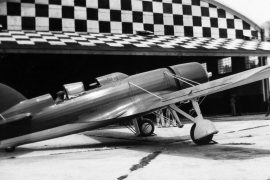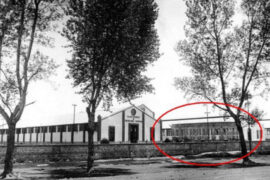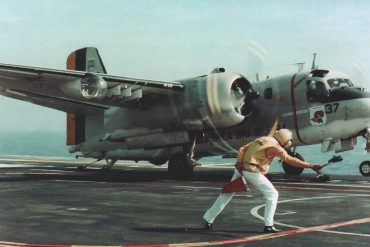The Mexican Air Force (Fuerza Aérea Mexicana, FAM) has a long history of combat aviation dating back to the early 20th century. However, it wasn’t until 1945 that Mexico established its first properly structured fighter squadron – the 201st Squadron of the Mexican Expeditionary Air Force, which fought alongside the United States in the Philippines during World War II. The P-47D Thunderbolts used by this squadron provided Mexican pilots with their first experience of a fully operational combat aircraft, featuring high speed, significant firepower, and good range.
In the following decades, Mexico’s fighter arm gradually evolved, transitioning from propeller-driven aircraft like the T-28 Trojan and AT-6 Texan to its first jet fighters. The de Havilland Vampire F.Mk.3, acquired in 1960, marked Mexico’s entry into the jet age. However, these aircraft had a relatively short service life, being retired by 1967 due to a high number of accidents.
Following the Vampires, the FAM acquired Lockheed T-33 jet trainers in 1961. These versatile aircraft, affectionately known as “Tetras” in Mexican service, played a crucial role in the development of Mexico’s jet combat capabilities. The T-33s served multiple roles including jet transition training, light attack, interception training, and visual reconnaissance. Their 46-year service life, which ended in 2007, was a testament to both the aircraft’s robust design and the exceptional maintenance work of Mexican mechanics.
While the T-33 provided valuable service, the most significant leap in Mexico’s air combat capabilities came with the acquisition of the Northrop F-5E/F Tiger II in 1982.
Acquisition and Introduction
The story of the F-5 in Mexican service began in the late 1970s when Mexico embarked on a comprehensive modernization program for its armed forces. This initiative was partly driven by the discovery of new oil reserves, which elevated Mexico’s strategic importance and necessitated a reassessment of its defense capabilities.
Initially, Mexico sought to acquire 26 F-5E fighters through the U.S. Foreign Military Sales program. However, this request was initially rejected by the U.S. Congress, which deemed such advanced combat aircraft unnecessary for Mexico at the time. In response, Mexico explored alternative options, including negotiations with Israel for the purchase of 24 Kfir C-2 fighters in 1981. This deal, which also included plans for local assembly and production for the Latin American market, ultimately fell through due to U.S. restrictions on the re-export of the General Electric J79 engines used in the Kfir.
After further negotiations with the United States, a compromise was reached. In 1982, Mexico was authorized to purchase 12 F-5 aircraft: 10 single-seat F-5Es and 2 two-seat F-5Fs. The contract, named “Peace Aztec” or “Proyecto FMS IF-70,” included not only the aircraft but also training programs for pilots and mechanics, spare parts, armament, and ground maintenance equipment.
The first F-5E/Fs arrived in Mexico in August 1982. On August 10, the first two aircraft (F-5F 4501 and F-5E 4001) landed at Military Air Base No. 1, piloted by Lt. Col. Ernesto Arcos Oropeza and Major Julio Ponte Romero. The deliveries continued throughout the month, with the last of the initial batch arriving on August 28. These aircraft were assigned to the newly formed Escuadrón Aéreo de Defensa 401 (Air Defense Squadron 401), based at Santa Lucía Air Base in the State of Mexico.
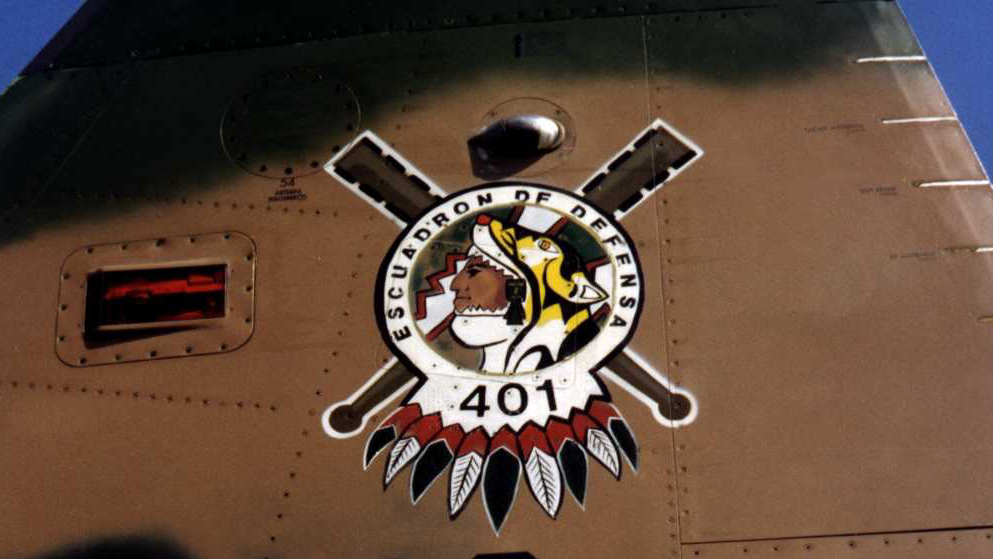
Operational History
The F-5E/Fs represented a quantum leap in capability for the FAM. They were the first supersonic fighters in Mexican service and brought new tactical and operational possibilities. The primary missions assigned to the EA-401 included safeguarding vital national installations, patrolling border areas, contributing to counter-narcotics operations, training flight crews, providing a credible deterrent against potential external threats, and supporting civilian population in case of natural disasters through aerial reconnaissance.
The F-5E/Fs made their public debut on September 16, 1982, during Mexico’s Independence Day celebrations. Seven aircraft participated in an aerial display over Mexico City, marking the first time supersonic fighters had been seen in Mexican skies.
Throughout their service life, the F-5E/Fs have been involved in various interception missions. One notable incident occurred on June 21, 1996, when F-5Es, alongside T-33s, intercepted an aircraft illegally entering Mexican airspace from the Pacific Ocean. The intercepted aircraft, a King Air with false registration, was forced to land and was found to be carrying nearly a ton of illicit drugs.
Initially, the F-5Es were serialled from 4001 to 4010, while the F-5Fs were serialled 4501 and 4502. However, in 1998, following two major accidents, the F-5Es were re-serialled from 4503 to 4510, while the F-5Fs retained their original serials.
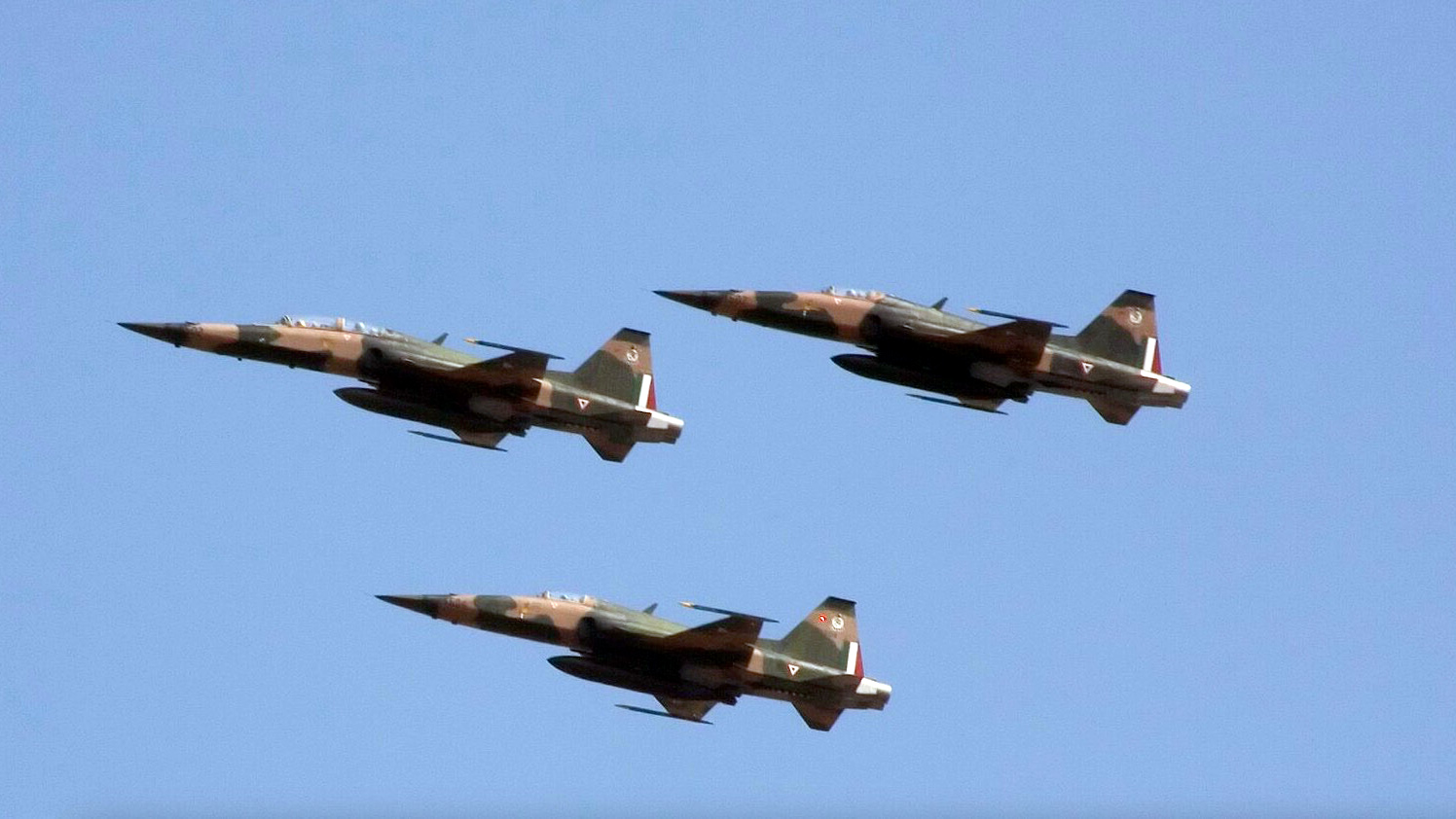
Armament and Upgrades
The initial armament package for the Mexican F-5E/Fs included:
- AIM-9B Sidewinder air-to-air missiles.
- LAU-3 and LAU-131 rocket launchers.
- MK-82 (500 pounds) and MK-83 (1000 pounds) bombs.
In 1995, the aircraft underwent a modernization process that included the installation of GPS and new navigation systems. Around the same time, Mexico acquired a small batch of more advanced AIM-9P missiles, though information about their operational use is limited.
In 2005, the Derco Company was awarded a contract to equip the FAM’s Tigers with new AN/APQ-159 V-5 radars, further enhancing their combat capabilities.
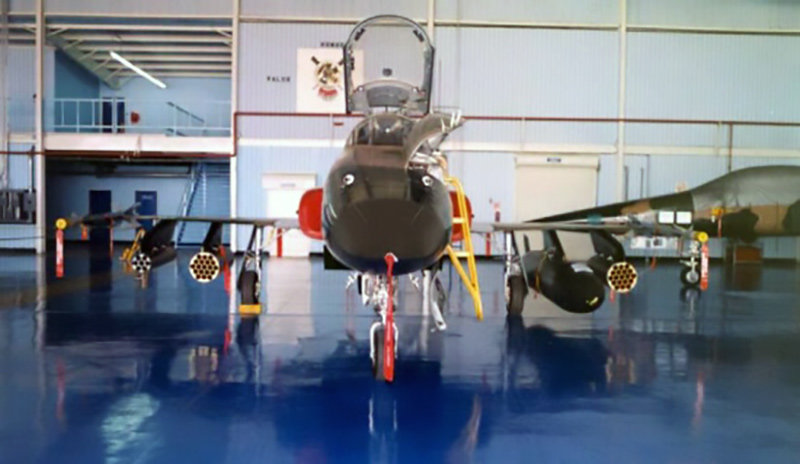
Color Schemes and Special Liveries
The Mexican F-5E/Fs wear a unique camouflage scheme often referred to as “Southeast Asia” or “jungle” pattern. It consists of two shades of green (Federal Standard color codes FS34102 and FS34079) and a light brown (FS30279). This scheme is a combination of the U.S. Navy Special Scheme and the USAF Standard Camouflage Scheme, with the unique feature of extending to the underside of the aircraft in a wraparound pattern.
Throughout their service life, the F-5E/Fs have worn various special liveries to commemorate important dates and events, including the 20th and 25th anniversaries of their service in Mexico, and the 91st anniversary of the Mexican Air Force.
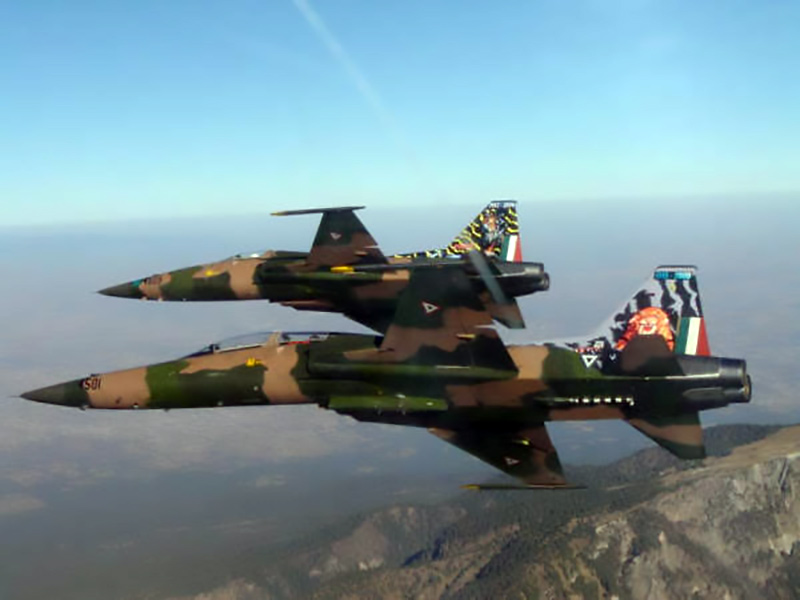
Incidents and Accidents
The Mexican F-5 fleet has experienced several significant incidents:
- In November 1983, F-5E serial number 4002 crashed in the desert in Chihuahua during an annual military exercise.
- On September 16, 1995, during the Independence Day aerial parade, F-5E serial number 4003 was involved in a mid-air collision with a T-33 trainer (JE-036). This tragic accident resulted in the loss of both aircraft and their crews, as well as two additional T-33s (JE-049 and JE-050). The incident led to the suspension of aerial displays in Independence Day parades until 2001.
- On November 9, 2017, F-5F serial number 4502 suffered a nose gear collapse at Santa Lucía Air Base. While not considered a severe accident, and even though the F-5F 4502 was eventually repaired, it highlighted the aging fleet’s maintenance challenges and symbolically marked the end of Mexico’s supersonic era for many observers.
These accidents reduced the fleet from the original 12 aircraft to 8 F-5Es and 2 F-5Fs.
It’s important to note that incidents involving Mexican F-5 operations were not limited to Mexican airspace. A United States Air Force document (IRISNUM 01082334, reel 4120) held in the U.S. Air Force Historical Archives, and interestingly classified as “Secret,” reveals a tragic incident during training in the United States. On October 15, 1986, a USAF F-5E aircraft, piloted by a Mexican Air Force Captain enrolled in the Operational Training Course with the 425 Tactical Fighter Training Squadron (TFTS), crashed while approaching Williams Air Force Base in Arizona. This incident underscored the risks involved in advanced fighter training and the close cooperation between the U.S. and Mexican Air Forces in developing Mexico’s F-5 capabilities.
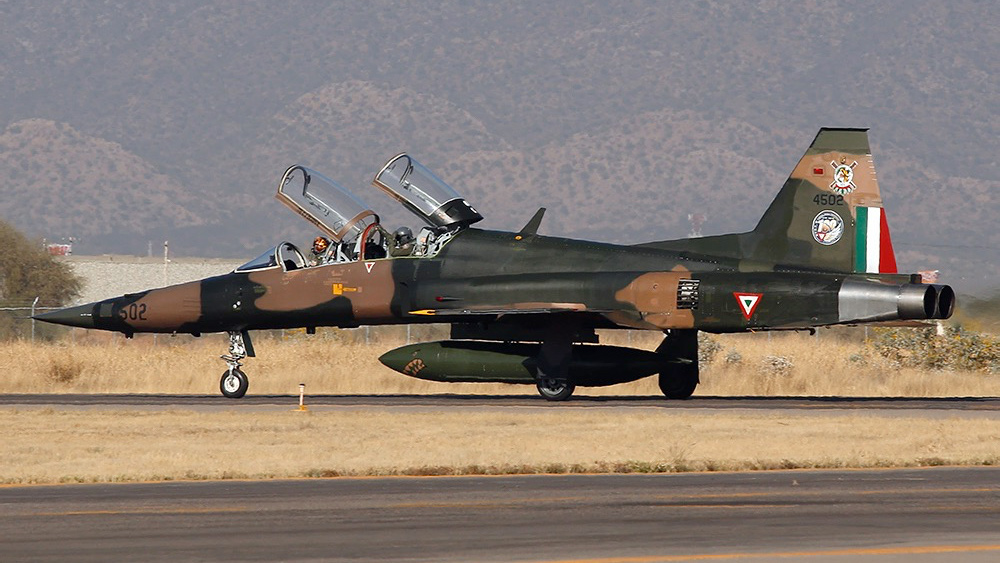
Current Status and Future Prospects
As of 2024, the status of Mexico’s F-5E/F fleet is uncertain. Reports from 2023 suggested that only three to five of the remaining ten aircraft were in relatively operational condition, with possibly only one or two capable of flying (See the table below.) The aircraft have never undergone a comprehensive modernization program, and maintenance issues, particularly with the engines, have significantly impacted their operational readiness.
Despite reports of their retirement in 2016, some F-5s have continued to operate in limited capacity. By 2019, the FAM was reported to maintain four F-5s in operational condition, but their combat effectiveness was limited due to outdated avionics and ongoing maintenance challenges.
The future of supersonic combat aircraft in Mexican service remains unclear. Various options have been considered over the years:
- In 2007, there were negotiations to purchase 12 Lockheed Martin F-16 Fighting Falcon aircraft, but economic conditions prevented this acquisition.
- The Swedish JAS 39 Gripen NG has been mentioned as a possible replacement.
- More recently, there have been discussions about potentially acquiring Yakovlev Yak-130 aircraft from Russia, which could serve both as trainers and light combat aircraft.
- The Korean T-50 Golden Eagle has also been considered as a potential option.
Despite these considerations, as of 2024, no firm decisions have been made regarding the replacement of the F-5 fleet. The situation leaves Mexico in a position where its air defense capabilities have been significantly degraded over the past decade. The lack of a clear replacement plan and the challenges in maintaining the existing F-5 fleet have effectively left the country without an effective supersonic air defense capability.
As Mexico continues to evaluate its air defense needs in the 21st century, the decision on the future of its fighter fleet will likely be influenced by budgetary constraints, strategic considerations, and the evolving security landscape in the region. The legacy of the F-5E/F Tiger II in Mexican service stands as a reminder of the country’s ambitions for a modern air force, and the challenges faced in maintaining such capabilities over the long term.
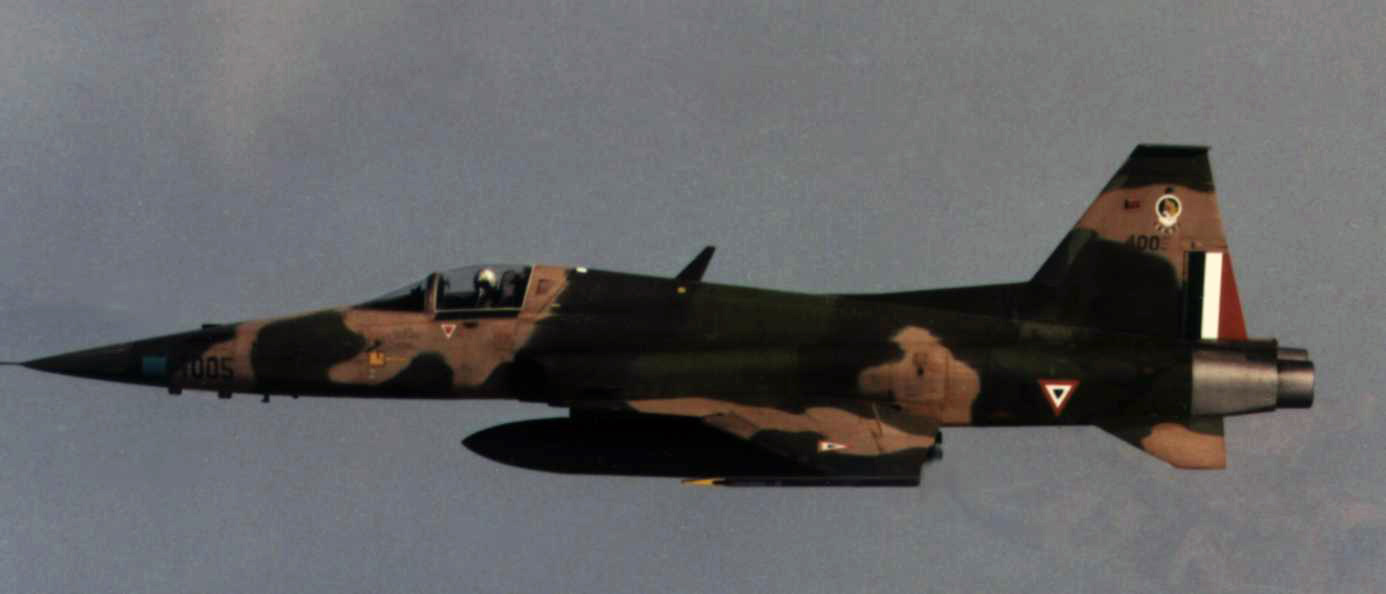
Fleet Information
| Type | C/N | FAM Serial | Prev. ID | Remarks |
| F-5E | MX.1001 | 4001 | USAF 81-0632 | Re-serialled as 4503. Stored (as of Apr-23.) |
| F-5E | MX.1002 | 4002 | USAF 81-0633 | w/o 25-nov-83. |
| F-5E | MX.1003 | 4003 | USAF 81-0634 | w/o 16-sep-95. |
| F-5E | MX.1004 | 4004 | USAF 81-0635 | Re-serialled as 4504. Active (as of Sep-23.) |
| F-5E | MX.1005 | 4005 | USAF 81-0636 | Re-serialled as 4505. Preserved, Museo Militar de Aviación. |
| F-5E | MX.1006 | 4006 | USAF 81-0637 | Re-serialled as 4506. Active (as of Sep-23.) |
| F-5E | MX.1007 | 4007 | USAF 81-0638 | Re-serialled as 4507. Active (as of Sep-23.) |
| F-5E | MX.1008 | 4008 | USAF 81-0823 | Re-serialled as 4508. Active (as of Apr-23.) |
| F-5E | MX.1009 | 4009 | USAF 81-0824 | Re-serialled as 4509. Active (as of Apr-23.) |
| F-5E | MX.1010 | 4010 | USAF 81-0825 | Re-serialled as 4510. Active (as of Apr-23.) |
| F-5F | MY.1001 | 4501 | USAF 81-0639 | Active (as of Sept-23.) |
| F-5F | MY.1002 | 4502 | USAF 81-0640 | Stored (as of Apr-23.) |
Documentary Sources
- Book: Quevedo, José Antonio. “Caballeros Aguila Fuerza Aerea Mexicana.” Editorial Albatros.
- Book: Ruiz Romero, Manuel. “Aviación militar.”
- Website: Scramble.nl
- Website: Saorbats.com.ar (No longer online.)
- Website: Infodefensa.com. García, Mariano. “Un F-5 de la FAM sufre un accidente en la base de Santa Lucía.” November 15, 2017.
- Website: Mexicoaeroespacial.mx. Quevedo, José A. “Cuando México tenía más de 50 jets de entrenamiento T-33.” July 8, 2024.
- Website: Mexicoaeroespacial.mx. Quevedo, José A. “Es conveniente para México ¿operar F-16 de segunda mano como Argentina?” June 28, 2024.
- Website: Mexicoaeroespacial.mx. Quevedo, José A. “Esquemas especiales de los interceptores mexicanos.” December 12, 2021.
- United States Air Force. USAF Historical Document (IRISNUM 01082334, reel 4120). October 15, 1986.
- Article: de Cherisey, Erwan. “The Fuerza Aerea Mexicana’s F-5s Tiger II.” LAAHS – France.
- Website: Wikipedia. “F-5 en servicio con México.”

